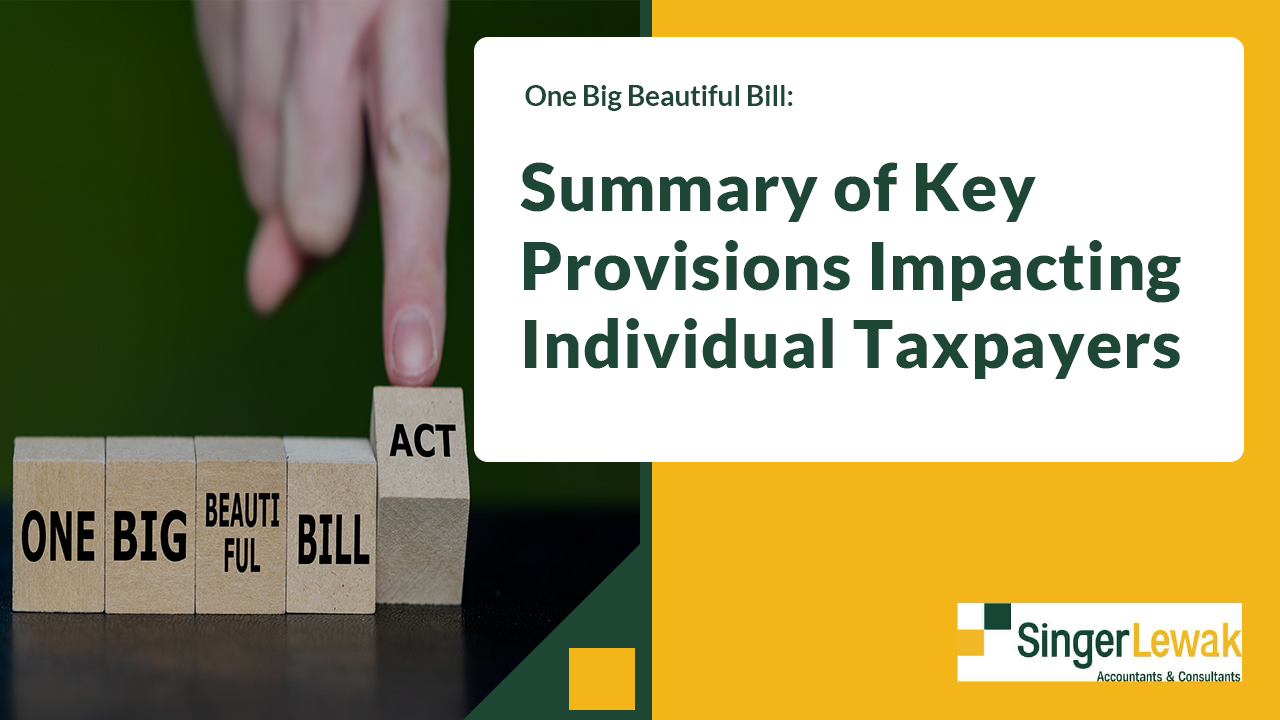The One Big Beautiful Bill (“OBBB” or the “Act”) was signed into law on July 4, 2025. The OBBB contained many important tax changes that are likely to impact significant numbers of individuals and businesses in current and future tax years.
The following items represent key OBBB provisions impacting individual taxpayers:
Reduced Income Tax Rates Made Permanent: The lower individual income tax rates and wider tax brackets introduced by the Tax Cuts and Jobs Act (“TCJA”) are now permanent under the OBBB. The seven tax brackets are as follows: 10%, 12%, 22%, 24%, 32%, 35% and 37%. All tax brackets will continue to be indexed for inflation after 2025.
Increased Standard Deduction: The standard deduction introduced by the TCJA has been permanently increased and enhanced for 2025 and beyond. The following standard deductions are effective as of January 1, 2025:
- $31,500 for joint filers,
- $23,625 for heads of household, and
- $15,750 for singles.
Child Tax Credit: The Child Tax Credit (CTC) has been permanently increased to $2,200 per qualifying child for tax years after 2024 and will be indexed for inflation in future years.
Miscellaneous Itemized Deductions: Miscellaneous itemized deductions for individual taxpayers are permanently eliminated. The Act adds a new deduction for educators, allowing K–12 teachers, counselors, coaches, and aides working at least 900 hours per year to deduct unreimbursed classroom expenses starting in 2026.
SALT Deduction Increase: The deduction for state and local taxes temporarily increases from $10,000 to $40,000 beginning in 2025. Beginning in 2030, the $10,000 “SALT cap” will return. The SALT deduction is subject to a phaseout for taxpayers with a modified adjusted gross income of over $500,000 for joint filers and $250,000 for single filers.
Estate and Gift Basic Exclusion Amount: The basic exclusion amount for federal estate and gift tax will permanently increase to $15 million (indexed for inflation) for estates of decedents dying and gifts made after Dec. 31, 2025.
Individual Alternative Minimum Tax Exemption Amounts: The AMT exemption amounts are permanently increased for 2026 and beyond, but the phaseout rate for higher-income taxpayers doubles from 25% to 50%.
Enhanced Deduction for Seniors: For tax years 2025–2028, individuals aged 65 or older (and their spouses, if filing jointly) can claim a new $6,000 deduction per qualified person. The deduction has a phaseout when adjusted gross income (AGI) exceeds $75,000 (single) or $150,000 (joint).
Car Loan Interest: Individuals, whether or not itemizing, can deduct up to $10,000 per year in interest paid on loans for new, personal-use vehicles for tax years 2025 through 2028. The deduction phases out for single filers with MAGI over $100,000 and joint filers over $200,000. The loan must be for a new, U.S.-assembled vehicle that is under 14,000 pounds.
Child and Dependent Care Credit: Starting in 2026, the Child and Dependent Care Credit will be more valuable for many families. The maximum credit rate increases to 50% of eligible expenses, up to $3,000 for one qualifying individual or $6,000 for two or more. The full 50% rate applies to families with AGI up to $15,000 and gradually phases down to 35% for AGI up to $75,000 ($150,000 for joint filers).
Deduction for Qualified Residence Interest: The deduction for mortgage interest on home acquisition debt is now permanently capped at $750,000 ($375,000 if married filing separately).
Trump Accounts: The OBBB allows for taxpayers to open a new tax-deferred investment accounts for children. Taxpayers can contribute up to $5,000 per year in after-tax dollars for each child, and funds must be invested in a diversified U.S. equity index fund. For children born between Jan. 1, 2025, and Dec. 31, 2028, the federal government will automatically contribute $1,000 to each account.
Qualified Higher Education Expenses: Changes to 529 savings plans allow families to use tax-free distributions for a much broader range of K-12 education expenses including not just tuition, but also curriculum, books, online materials, tutoring, standardized test fees, dual enrollment, and educational therapies for students with disabilities. Starting in 2026, the annual limit for K-12 distributions doubles from $10,000 to $20,000 per beneficiary.
In addition, 529 plan distributions can now be used tax-free for a wider range of education expenses, including not only college costs but also “qualified postsecondary credentialing expenses.” This means you can use 529 funds for tuition, fees, books, supplies, and equipment required for enrollment in recognized certificate, licensing, or apprenticeship programs even if they are not traditional degree programs.
Non-Itemizer Charitable Deductions: Beginning in 2026, non-itemizers may claim a charitable deduction, not in excess of $1,000 ($2,000 for a joint return). To qualify, the contribution must be made in cash to a public charity.
Limitation on Casualty Loss Deduction: Starting in 2026, personal casualty loss deductions are permanently limited to losses from federally declared disasters (and certain state-declared disasters).
Additional information about the above items, among others, specifically impacting individual taxpayers will be addressed in upcoming articles and alerts.
The Act is an extensive body of legislation and will likely produce multiple iterations of regulatory and administrative guidance in the near future. Navigating these changes can and will be complex, and their impact on your specific tax situation will vary. Contact us below for more information on steps that can be implemented to take advantage of potential tax planning opportunities now that the OBBB passed.
Author’s note: Additional articles focused on business, state, and international changes stemming from the OBBB will soon be released.



